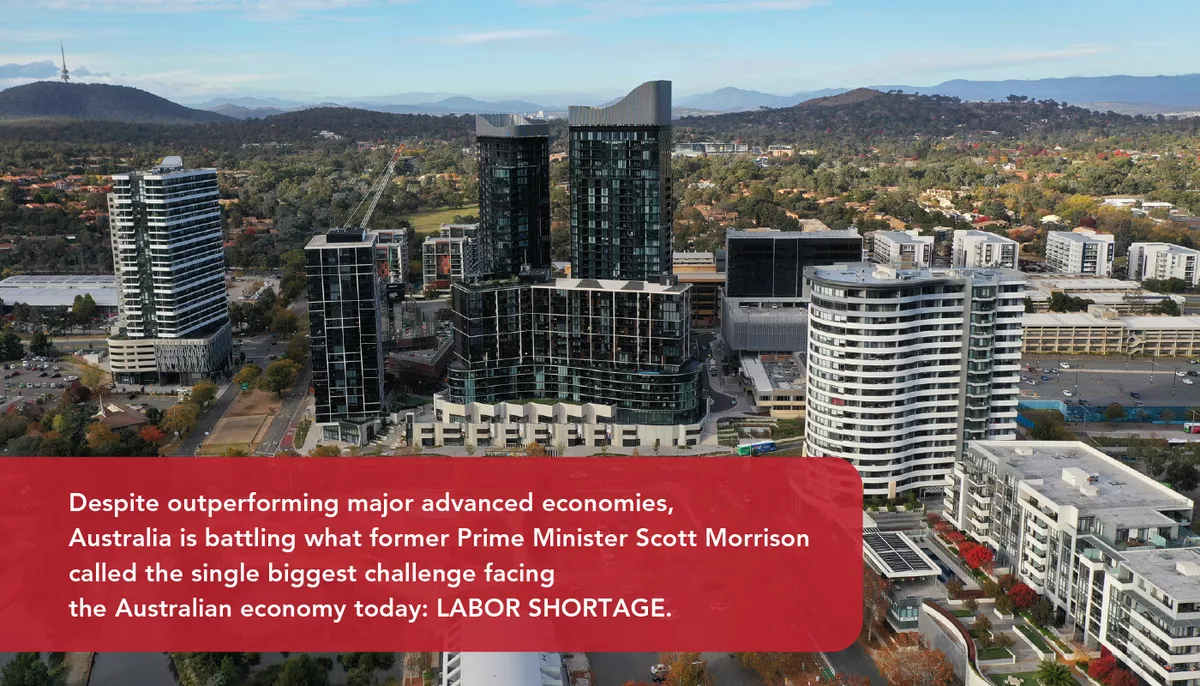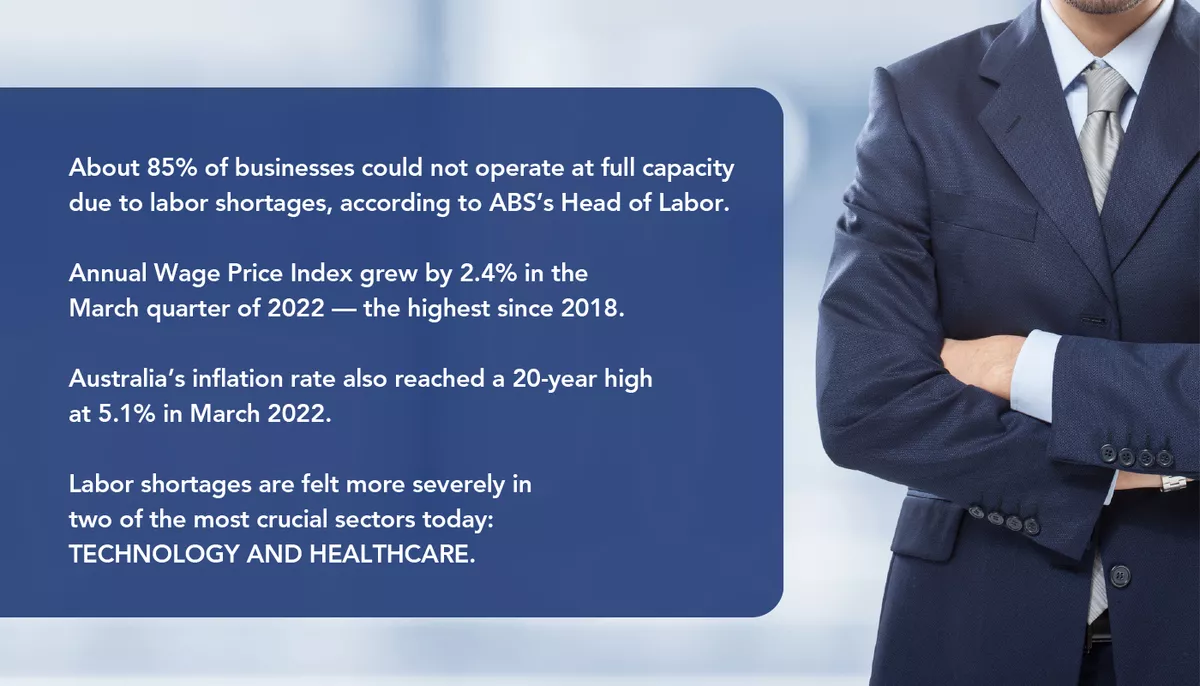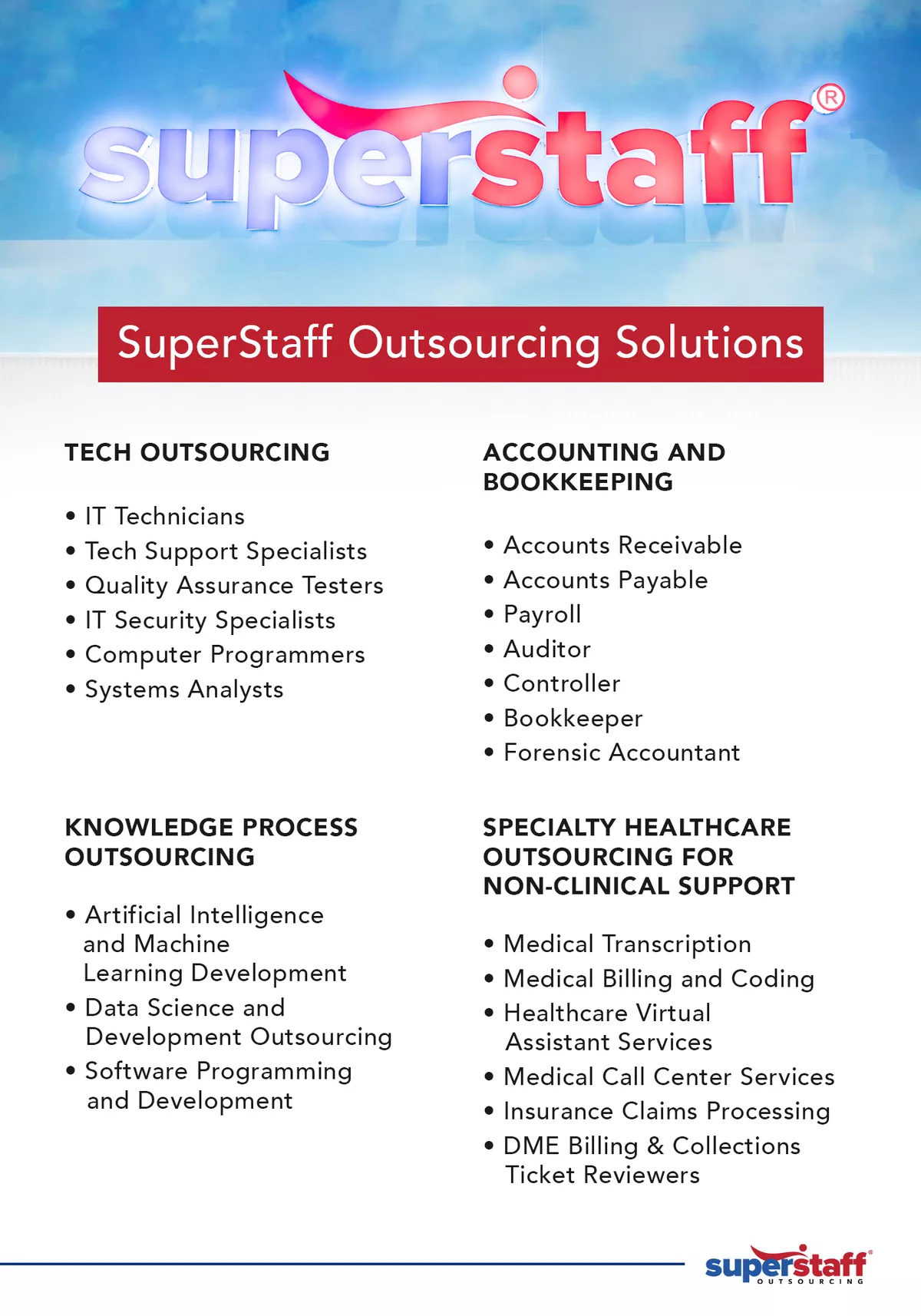
Australia is one of the few countries that have managed to bounce back strongly from COVID-19’s adverse economic impacts. After falling significantly by 871,600 between March and May 2020, the country’s employment increased to 12,773,900 in October 2020.
Australia’s labor market further improved as restrictions eased and more economic activities resumed. According to the Australian Bureau of Statistics, the Land Down Under logged a record-low 3.5% unemployment rate in December 2022.
But one major problem challenges Australia’s status.

Land Down Under’s current labor market is at its tightest since 2008. In fact, according to an OECD economic outlook report, the country’s labor shortage is second-most severe in the developed world.
Hiring signs have become increasingly common in the country, with many businesses struggling to fill job openings. As of July 2022, 480,500 job vacancies remain unfilled — around 200,000 more than in February 2020.
Without immediate and effective intervention, industry observers say Australia’s acute labor shortage could impede the country’s economic recovery and growth. Worse, it could cripple some of its most crucial sectors.
An In-Depth Look at Australia’s Acute Labor Shortage
What’s driving Australia’s labor shortage?
The decline in the influx of migrant workers contributes significantly to Australia’s labor shortage. By closing its borders to foreign visa holders, it experienced the first drop in the migrant population since 1946, decreasing from an annual growth rate of 1.5%. The pause on overseas migration created a worker shortage, leading to the tightest job market the country has ever seen since 2008.
From June 2020 through mid-2021, over 97,000 people, many of whom were students and workers, left the country permanently due to the expiration of temporary visas. The labor crisis led two of Australia’s biggest listed companies, the toll-road giant Transurban Group and diversified property group Mirvac, to call for an increase in skilled migration to help businesses address the tight labor market.
Other factors driving labor shortages in Australia are:
- Businesses’ rapid and wide-scale adoption of automation, artificial intelligence, and other advanced technologies
- Resumption of economic activities
- Increasing demands for COVID and non-COVID-related healthcare services
How Labor Shortages Impact Australian Businesses and Economy
➡️Difficulty Finding Talent? Hear From Our Talent Acquisition Experts

Downscaling Operations
About 85% of businesses in the Land Down Under could not operate at full capacity due to labor shortages, according to ABS’s Head of Labor. Restaurants, cafes, shopping centers, and firms have been forced to limit services. Companies have been offering hefty pay increases to attract quality hires. Many small businesses fear they may have to cease operations entirely if staff shortages persist.
Increasing Wages
Businesses conformed to offering higher wages to attract quality candidates. The country’s annual Wage Price Index grew by 2.4% in the March quarter of 2022 — the highest since 2018. It is forecasted to accelerate to 3.0% by the end of 2022 and 3.7% by mid-2024.
Surging Inflation
Consequently, the wage rate increase drove the prices of consumer goods to increase drastically. In March 2022, Australia’s inflation rate reached a 20-year high at 5.1%.
Even though inflation is lower than in many other countries, the increased rates have negatively affected business operations and consumer spending. For instance, fast-food giant KFC announced that they would start using cabbage leaves in their sandwiches instead of lettuce due to rising food prices.
To battle rampant inflation, the country’s central bank has raised interest rates by 50 basis points to 0.85% in June. The Reserve Bank of Australia’s decision joins a broader global push to dampen the threat of inflation and tighten monetary policies as a response to the effects of the coronavirus pandemic.
Which sectors are adversely affected by Australia’s labor crunch?
While talent shortages are rampant across industries, their impacts are felt more severely in two of the most crucial sectors today: technology and healthcare.
The widespread digital transformation efforts of the Australian government, businesses, and workplaces have rapidly increased the demand for tech workers. But as employers struggle to attract candidates with the skill sets required for the specialized roles, tech talent shortages grow more pronounced.
Meanwhile, the lack of skilled migration due to travel restrictions for more than two years further strains the pandemic-battered healthcare sector. Many hospitals struggle to meet patients’ needs for urgent care, and healthcare workers are stretched beyond limits.
Other sectors with the highest demands for workers are:
- Food and Accommodation (+213% Job Openings)
- Arts and Recreation Services (+211% Job Openings)
- Rental, Hiring, and Real Estate (+191% Job Openings)
The State of Australia’s Tech Sector and Labor Market
➡️Connect With Thousands of Talent Worldwide! Contact Us

During the earlier stages of the pandemic, the government relied on technology to make data-guided decisions and formulate approaches that proved relatively effective in curbing the infection rate.
Private businesses have also realized the integral role of intelligent technology in ensuring business survival and growth. Enterprises across industries are racing to develop and adopt a digital-first business model.
As the world and country reopen to the new normal, the rate and pace of Australia’s digital transformation will continue to point upward — especially as the government pushes its vision to be a top digital economy.
Australia aspires to become a leading digital economy.
By driving robust digital transformation, the government aims to be among the top 10 digital economies and societies by 2030. The Digital Economy Strategy outlines the key investments the government has undertaken to realize this grand vision.
To improve the country’s digital economy, the government commits to making the following investments from 2022 to 2023:
- $38.4 million to utilize consumer data in developing a more innovative and competitive data ecosystem
- $30.2 million to improve the cybersecurity of government agencies
- $18.6 million to shape global critical and emerging technology standards
- $13.6 million to digitalize the transportation sector
- $6.2 million to develop a Digital Age Policy and position Australia as a world leader in regulating the global digital economy
- $4.8 million for the Digital Technology Taskforce
- $3.9 million to support more women entering the tech workforce
- $1.8 million to develop regulatory frameworks and funding arrangements for the Digital Identity system
- An undisclosed amount to support the Department of Industry, Science, Energy, and Resources in fast-tracking technology development
Australia’s tech sector is booming.
The government’s commitment to continuously develop and adopt new and emerging technologies contribute to the tech industry’s growth.
Additionally, the Labor Party has pledged to help create 340,000 new tech jobs by 2030, aligning with the Tech Council of Australia’s vision of reaching 1.2 million jobs by the decade’s end.
These efforts, combined with the private companies’ wide scale tech transformation initiatives, will continue to push the demand for talents with specialized tech skills. By 2030, the additional tech jobs are projected to add $63 billion to the economy annually, climbing from $187 billion to $250 billion.
Australia urgently needs tech upskilling to keep up with the fast-growing demands.
Despite optimistic projections on the country’s booming tech industry, one significant roadblock stands in the way: the digital skills gap.
An RMIT Online report revealed that 4 in 5 Australian business leaders say adopting new technologies is essential for achieving business goals. Thus, more than 87% of jobs now require digital skills.
Employees don’t feel confident with their digital skills.
Many Australian workers say they lack the necessary skills or education to take on tech roles, revealing an urgent need for education and upskilling. The RMIT Online report added that:
- 1 in 3 workers feel their job requirements have changed, and 1 in 4 said they don’t have the skills to complete their daily tasks.
- More than 50% of Australian workers said they do not understand coding, blockchain, artificial intelligence (AI), and data visualization.
- 1 in 4 workers said they are worried that technology will make their job redundant.
- 3 in 4 Australian workers want to learn about emerging technologies such as AI and cybersecurity. However, 23% say that tech training and education are often unavailable during times or in ways that suit them.
Employers have challenges filling specialized tech roles.
According to Randstad Australia’s 2020 Employer Brand Research, 56% of tech hiring leaders struggle to find candidates with the right skillsets, particularly management roles.
Meanwhile, the Australian Information Industry Association survey found that 75% of tech companies predict their revenue will grow by at least 5% by the end of 2022. However, they are concerned that the skills shortage will impede their business growth.
Addressing Australia’s tech skills shortage requires short-term and long-term solutions.
Businesses must focus on developing strategies to win today’s talent war while simultaneously investing in building a deep pool of talents to sustain long-term goals. Therefore, overcoming the tech talent shortage requires immediate and long-term solutions.
Education and Training
In a 2020 report on Australia’s tech skills shortage, most of the respondents noted that the country’s education system was a barrier to building a competent and reliable tech workforce.
- 56% of survey respondents say that the tech industry needs to work closely with education to make the sector more appealing to students.
- 58% say that education establishments do not offer enough variety for those wishing to study in the tech space.
- 56% say that the country’s education system does not offer courses that adequately train and prepare students for tech jobs.
To help make tech education more accessible to the average citizens, the government pledged to create 465,000 Technical and Further Education (TAFE) centers and 20,000 additional university placements.
Competitive Salary
Increasing wages is one proposed solution to entice more Australians to consider switching to a tech industry job. In fact, the annual salaries demanded by IT workers, especially those specializing in DevOps, software development, and UX design, have risen by 10 to 17% in the early months of 2022.
Visas and Skilled Migration
In addition to nurturing homegrown talent, businesses can also pull from a global talent pool by promoting skilled migration. The Global Talent Employer Sponsored (GTES) program allows tech companies to fill in immediate skills gaps through visa arrangements. Other experts have also proposed enticing expat Australian tech specialists and scientists to return home.
To illustrate how vital it is for the government to prioritize skilled migration, consider this: Engineers are among the country’s most in-demand tech jobs, particularly civil, industrial, mechanical, and production engineers. In 2021, engineer job openings increased by 50% compared to the previous year, hitting a ten-year high in demand.
However, the long wait time for Australia’s 476 visas, designed for engineering graduates, keeps skilled engineers from moving to the country. Overseas engineers must wait up to 41 months to get approved for a visa because of the extensive backlogs.
Tech Support Process Outsourcing
Another way tech companies can fill tech talent shortages is through outsourcing. By partnering with a provider offering specialized remote staffing, businesses can address immediate labor gaps without going through the long and arduous process of obtaining visa arrangements for skilled migrant workers.
The State of Australia’s Healthcare Sector and Labor Market
➡️Build My Outsourced Team! Contact Sales

The massive shortage of healthcare workers, accelerated by the COVID-19 pandemic, remains the biggest problem for Australia’s public health system. According to The National Skills Commission, the Land Down Under will need 250,000 more qualified health and social care workers from 2022 to 2027 to meet increasing demands.
As hospitals struggle to fill vacant roles, patients and healthcare workers suffer. The sector is in dire need of immediate reinforcement.
Backlogs in essential surgery are at record levels.
Emergency departments are overflowing with patients without sufficient doctors and nurses to handle urgent care and treatments, and the waiting lists for specialist care and surgeries are at a record high.
A report from the Australian Institute of Health and Welfare revealed that in 2020 to 2021:
- 754,600 patients were on public hospital elective surgery waiting lists (9.6% higher than the previous year).
- 50% of patients waited 48 days before being admitted for elective surgery (39 days longer than the previous year).
- The number of patients transferred to another hospital’s waiting list increased by 40%.
The dire situation continues in 2022. In Victoria alone, more than 89,000 patients are waiting for elective surgery. According to the Victorian Australian Medical Association’s president, the updated figures could be as high as 120,000.
Hospitals are declaring internal emergencies due to staff shortages.
The severe imbalance in the demand and supply of healthcare professionals has forced some organizations to implement desperate measures. In April 2022, four regional hospitals declared “code yellow” due to weeks-long staff shortages, indicating an internal emergency and adversely affecting hospital service delivery.
Severe understaffing pushes many healthcare workers nearing breaking point.
Patients are not the only ones suffering because of healthcare staffing shortages. As the problem persists, nurses and doctors endure long shifts and taxing workloads daily, taking a toll on their physical, mental, and emotional well-being.
In February 2022, at least 5,000 nurses across NSW went on a strike to demand mandated staff-to-patient ratios. Others have taken a more drastic response and chose to walk away from the sector, further exacerbating the workforce shortage. In 2020 alone, more than 20,000 nurses left the profession.
What’s causing the healthcare workforce shortage in Australia?
Challenging Immigration Process
Low levels of skilled migration during border lockdowns and even after reopenings have contributed mainly to the healthcare workforce shortage. Industry observers added that red tape and overly complicated visa application processes prevent talented and qualified medical workers from moving to Australia.
Registering as a healthcare practitioner in the country is a lengthy process, and each step must be accomplished one at a time. The period needed to finish the process will depend on the specific healthcare profession a potential migrant is applying for. Each step usually takes about a month.
Some professions even take over a year to fully complete the process, including medical registration, securing a job offer, applying for a visa, and securing their registration and Medicare provider numbers. For many aspiring migrant healthcare workers, travel restrictions during the COVID-19 pandemic also contributed to the difficulty of immigrating to Australia.
Aging Workforce
In addition to the complex immigration process, the healthcare labor shortage is also exacerbated by an aging workforce. Nearly 50% of Australia’s medical labor force is over 50, signaling future problems for the healthcare system.
Studies have found that 43% of general practitioners and 56% of the specialist workforce will retire by 2025. Industry analysts fear that there will not be enough new healthcare workers to replace those who will soon retire.
Pandemic Burnout
As of May 2022, 7,267 new COVID-19 cases were reported in the country. Although case numbers have eased slightly, there are often not enough healthcare workers to address emergency hospitalizations.
The rising demand for healthcare and shortage of workers exerts greater stress and pressure on existing medical workers. They are often overworked and underpaid, leading many to experience burnout and decide to switch careers or leave the workforce entirely.
Addressing the Healthcare Workforce Shortage Through Technology
The Australian government is committed to helping the healthcare industry stay afloat amid the labor crisis by investing in digital health programs. From 2022 to 2023, the government committed $32.3 million to support digital health initiatives such as My Health Record and the Health Care Identifiers Service.
Additionally, the government is investing $2.9 million over four years to improve the cybersecurity and resilience of the Australian Institute of Health and Welfare.
How SuperStaff Can Help Australian Businesses Address Labor Shortages
The harsh global labor climate has pushed many businesses to downscale, forgoing top-line and bottom-line growth opportunities. Others have adopted measures that further strain their remaining workforce.
SuperStaff offers more efficient solutions to tackle labor shortages. We are a business process outsourcing company headquartered in the United States and the Philippines.
With access to a global talent pool, we help businesses fill the skills gap by building robust remote teams offshore. Our scalable solutions also allow enterprises of all sizes to respond swiftly and cost-effectively to the uncertainties of the labor market.
Key Outsourcing Solutions for Businesses in Australia
➡️Are You Doing Recruitment Wrong? Try To Hear What We Can Do For You

Recruitment Process Outsourcing
Finding and hiring the right talent can be challenging under the best circumstances and downright difficult amid the tight Australian labor market. By partnering with an RPO provider like SuperStaff, you can build and expand your workforce without going through lengthy visa applications and immigration processes.
SuperStaff can enable access to one of the deepest technical and volume recruiter talent pools globally. Whether you need software developers for your tech company or medical coders for your healthcare facility, we can efficiently address the talent gap in your organization.
Specialty Healthcare Outsourcing
Staffing shortages are taking a severe toll on Australia’s healthcare sector. As job vacancies remain unfilled, more frontline workers feel burned out and pushed to the brink of resignation.
One effective way to immediately address the issue is to acquire back-office outsourcing solutions from a provider with extensive experience and knowledge of the healthcare industry. By delegating repetitive and time-consuming tasks to a dedicated remote team, you can help remove a great deal of burden off your internal staff’s shoulders.
Even before the pandemic, SuperStaff has been instrumental in helping healthcare facilities and pharmaceutical companies of all sizes expand their technical capabilities without increasing overhead costs. We offer a variety of back-office outsourcing solutions specifically for the healthcare sector, including:
- Medical Transcription
- Medical Billing and Coding
- Healthcare Virtual Assistant Services
- Medical Call Center Services
- Non-Clinical Functions (Accounting, Supply Chain Management, Technical Support, etc.)
Knowledge Process Outsourcing
In today’s competitive business landscape, having high-level industry knowledge and leveraging data-driven strategies are paramount to an enterprise’s success. However, in cases where your core team lacks degrees or training in a specialized field, outsourcing can be the ideal solution.
For instance, Australian tech companies can opt for tech support process outsourcing or data science outsourcing to address urgent projects when it’s too challenging to hire and train in-house workers. Working with an outsourced sourcing specialist can also benefit healthcare facilities struggling with supply chain management.
Through specialty KPO services, SuperStaff can empower Australian clients to maximize their potential and foster business growth despite local worker shortages.
Gain the Support You Need With SuperStaff
➡️SuperStaff Is Trusted By Thousands of Partners. Get To Know Us Too! Book A Free Call
The pandemic has triggered a range of subsequent disruptions that make today’s labor climate the toughest for businesses. Allow SuperStaff to give you the support you need to power through and thrive. Consult one of our solutions architects today.






